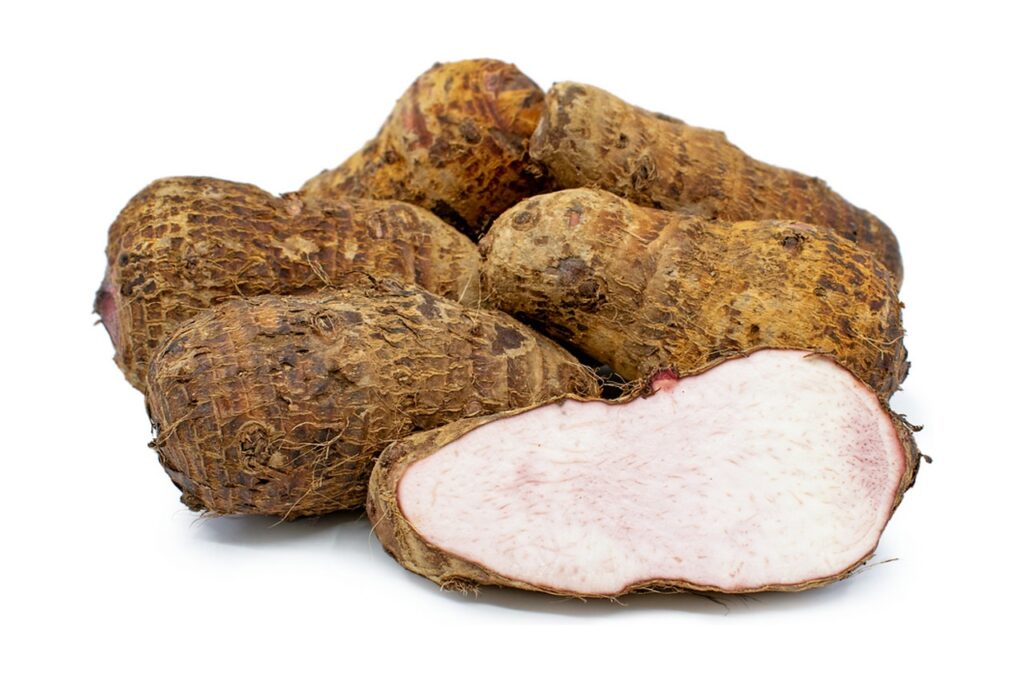Kachalu Vegetable: A Hidden Gem in Indian Cuisine
Indian cuisine is a treasure trove of culinary diversity, with a plethora of regional delicacies that can delight the taste buds and pique the curiosity of food enthusiasts. Amidst this rich tapestry, the “Kachalu vegetable” remains a hidden gem waiting to be discovered. In this blog, we will embark on a journey to explore the intriguing world of Kachalu, its origins, culinary uses, nutritional value, and why it deserves a place of honor in Indian cooking.

Kachalu Names
The “Kachalu vegetable,” also known as Taro or Arbi, goes by various names in different languages and regions. Here are some of the names by which it is known:
- Hindi: Kachalu (कचालू) or Arbi (अरबी)
- English: Taro, Colocasia
- Sanskrit: Trivrit (त्रिवृत)
- Bengali: Kochu (কচু)
- Marathi: Alu (आळू) or Aluchi Pane (अळूची पाणे)
- Tamil: Seppankizhangu (சேப்பஂக
The Mystery of Kachalu
Kachalu, also known as Taro or Arbi, is a starchy root vegetable native to Southeast Asia but has found its way into the heart of Indian kitchens. Its Hindi name “Kachalu” is derived from the Sanskrit word “kachala,” which means “to move,” likely referring to the plant’s mobility as it spreads through its underground corms.
Culinary Versatility
One of the most captivating aspects of Kachalu is its versatility in Indian cuisine. This unassuming vegetable is a chameleon in the kitchen, capable of adapting to various cooking methods and flavor profiles.
- Curries: Kachalu is often the star of delectable curry dishes. It absorbs the flavors of spices and seasonings beautifully, creating a mouthwatering blend of textures and tastes.
- Fried Delights: Sliced thinly and deep-fried, Kachalu transforms into crispy, irresistible snacks. Whether you’re making arbi chips or pakoras, these fried delights are a hit.
- Stir-Fries: Kachalu’s earthy flavor and slightly nutty taste make it an excellent addition to stir-fries. Mixed with other vegetables and spices, it adds a unique dimension to these dishes.
- Mash and Fry: Boil, mash, and then shallow fry Kachalu for a dish that’s crispy on the outside and creamy on the inside.
Nutritional Value
Kachalu is not just a taste sensation; it also offers several health benefits. This root vegetable is an excellent source of dietary fiber, vitamins, and minerals. It’s a good source of vitamin C, vitamin B6, and potassium. The high fiber content aids digestion, while the starchy nature provides a sustainable source of energy.
Cultural Significance
Kachalu has a special place in Indian culture. It is commonly used during fasting (vrat) as it’s considered “upwas-friendly.” The root is also symbolic in Hindu rituals and is used as an offering to deities during ceremonies.
Harvesting and Storage
Kachalu is typically in season during the monsoon and post-monsoon months. To prepare Kachalu for cooking, peel its hairy skin and cook it to remove its itchiness. Once peeled, it can be stored in the refrigerator for a few days.
Amazing Taste of Kachalu Leaves | Arbi ke Patte | Colocasia leaf
Here’s some information about Kachalu vegetable leaves:

1. Appearance: Kachalu leaves are typically large, heart-shaped, and can grow up to 12 inches (30 cm) in length. The leaves are dark green and have a glossy texture. They are attached to thick, fleshy stems.
2. Culinary Uses: Kachalu leaves are edible and are used in various regional and traditional cuisines. They have a slightly earthy and nutty flavor. The leaves can be used in a manner similar to spinach or other leafy greens.
3. Preparation: To prepare Kachalu leaves for cooking, follow these steps:
- Carefully remove the leaves from the stems.
- Wash the leaves thoroughly to remove any dirt or grit.
- The leaves can be used in a variety of dishes, including curries, stir-fries, and soups.
- When using the leaves, consider blanching them in boiling water for a few minutes to reduce their natural itchiness. Drain and rinse them in cold water before cooking.
4. Nutritional Value: Kachalu leaves, like the corms, are nutritious. They are a good source of dietary fiber, vitamins (such as vitamin C and vitamin A), and minerals (including potassium and magnesium). These leaves also contain antioxidants and can be a valuable addition to a balanced diet.
5. Regional Variations: Kachalu leaves are used in various regional cuisines across India and other parts of the world. In some areas, they are used in traditional dishes, while in others, they may be incorporated into everyday cooking.
6. Itchiness: One thing to note is that Kachalu leaves, like the corms, can cause itchiness or irritation in the mouth and throat for some individuals. To reduce this effect, blanching the leaves as mentioned earlier can help.
7. Traditional and Cultural Significance: In some cultures, Kachalu leaves are used in special dishes prepared during festivals or as offerings in religious ceremonies. Their culinary and cultural significance varies from region to region.
Kachalu leaves are a lesser-known but valuable part of this versatile plant. They not only offer a unique flavor to dishes but also bring nutritional benefits to the table. If you have access to Kachalu leaves and want to explore new flavors in your cooking, consider incorporating them into your recipes.
Final Words
Kachalu, the unassuming root vegetable, is a testament to the diversity and versatility of Indian cuisine. From its various culinary applications to its nutritional value, this hidden gem is ready to steal the spotlight in your kitchen. So, next time you’re exploring the local vegetable market, don’t forget to pick up some Kachalu and embark on a culinary adventure that celebrates the essence of Indian cooking.

